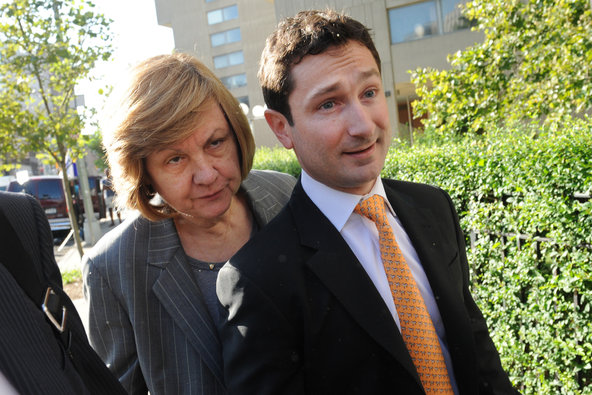 Louis Lanzano/Associated PressPamela Chepiga, left, a former federal prosecutor, with her client Fabrice Tourre.
Louis Lanzano/Associated PressPamela Chepiga, left, a former federal prosecutor, with her client Fabrice Tourre.
When Wall Street lawyers gathered at a conference in Orlando, Fla., during the 2008 financial crisis, one law firm posted an outsize picture of Sean Coffey’s head on the body of a wrestler, labeling him Public Enemy No. 1.
Five years later, Mr. Coffey’s role is reversed. Once famous for suing Wall Street — Mr. Coffey extracted $6.2 billion from big banks in the wake of WorldCom’s collapse — he is now defending a former Goldman Sachs trader, Fabrice Tourre, in one of the biggest actions stemming from the financial crisis.
Related Links
The Securities and Exchange Commission’s civil case against Mr. Tourre went to trial on Monday in a federal courthouse in Lower Manhattan, putting a spotlight on Mr. Coffey and a tightknit network of other legal players, many of whom are playing unusual roles in the case.
Mr. Coffey’s co-counsel is Pamela Chepiga, a former federal prosecutor who once played basketball with another diminutive lawyer, Mary Jo White, the chairwoman of the S.E.C. The defense team is facing off against the head of the S.E.C.’s trial unit, Matthew T. Martens, who typically supervises cases, but has never before led a jury trial at the S.E.C. (He is a friend of Mr. Coffey’s from private practice, though Mr. Martens temporarily unfriended Mr. Coffey on Facebook as a precautionary measure during the trial.) Rounding out the roster, the two sides will argue before Judge Katherine B. Forrest, a longtime corporate lawyer and relative newcomer to the bench who will face her biggest securities trial yet.
 Fred R. Conrad/The New York TimesFrom left, Sean Coffey, Fabrice Tourre’s attorney; Katherine B. Forrest, the presiding judge; and Matthew Martens, a lawyer for the S.E.C.
Fred R. Conrad/The New York TimesFrom left, Sean Coffey, Fabrice Tourre’s attorney; Katherine B. Forrest, the presiding judge; and Matthew Martens, a lawyer for the S.E.C.
The convergence of such prominent lawyers exemplifies the insular world of the securities bar — and the revolving door its members often pass through on their way back and forth between government and private practice. It also underscores the importance of a trial in which Mr. Tourre is fighting a possible ban from the securities industry, and the S.E.C. is seeking a defining victory in its uneven campaign to punish those at the center of the crisis.
In the Goldman case, the S.E.C. accused Mr. Tourre of misleading investors about a mortgage security that ultimately failed. Mr. Tourre, the agency says, sold what is known as a synthetic collateralized debt obligation, a deal linked to the performance of mortgage-backed bonds, while omitting a crucial fact: a hedge fund helped pick the bonds and then bet against them. Goldman chose to settle the case, paying a $550 million penalty without admitting or denying guilt.
On Monday, Ms. Chepiga explained to the nine-person jury that synthetic C.D.O.’s are structured such that someone needs to bet against the deals. One investor bets the bonds will fail; another bets they will pay out, creating what she called a “zero-sum game.”
Still, the case will test the lawyers’ ability to translate such sophisticated concepts — C.D.O.’s and mortgage bonds, to say nothing of hedge fund strategy — to a jury that includes a minister, a retiree and a graphic designer who likes to watch Fox 5 News.
“You guys are going to have a hard time making this case non-mumbo jumbo,” Judge Forrest told the lawyers at a hearing last week. Mr. Coffey later joked: “I couldn’t spell C.D.O. a few months ago.”
Mr. Coffey’s partner on the case, Ms. Chepiga, found her way into securities law as a young federal prosecutor working for Jed S. Rakoff, now one of New York’s best-known federal judges. While Ms. Chepiga has handled mostly securities cases at the Allen Overy firm, she also helped lead a team in 2004 that sued the government on behalf of 15 detainees from Yemen held on suspicion of terrorism at Guantánamo Bay.
In the Goldman case, Ms. Chepiga has represented Mr. Tourre since the S.E.C. filed its suit in 2010. And on Monday — which also happens to be both her and Mr. Coffey’s birthday, 64 for her and 57 for him — she delivered opening arguments in the case.
Mr. Coffey’s career has also included turns as a federal prosecutor and a defense lawyer. But unlike other securities lawyers, he is a retired naval officer who tracked Soviet submarines during the cold war and served as a personal military assistant to then-Vice President George H. W. Bush. He also defended a death-row inmate in one of the first cases involving DNA evidence.
But it was as a plaintiff’s lawyer at Bernstein Litowitz Berger Grossmann where Mr. Coffey became an enemy of Wall Street. Tom Ajamie, a securities lawyer who attended the seminar in Orlando, said the message was clear: “Here is the guy you need to attack.”
The WorldCom case, possibly Mr. Coffey’s biggest success at Bernstein, led him to Ms. Chepiga. While he was suing WorldCom’s banks and directors, she represented some of the directors.
Mr. Coffey left Bernstein in 2009 and began what turned out to be an unsuccessful bid for New York attorney general.
He went on to create BlackRobe Capital Partners, which helped finance litigation against big corporations, but he closed the company recently before joining Mr. Tourre’s legal team. One of his partners at BlackRobe was Ms. Chepiga’s husband, Michael J. Chepiga.
While Mr. Coffey is also friends with Mr. Martens from their days at the corporate law firm Latham Watkins, the similarities appear to stop there. Mr. Coffey is a liberal Democrat. Mr. Martens, after graduating first in his class from the University of North Carolina School of Law, was a law clerk to William H. Rehnquist, the conservative former chief justice of the Supreme Court.
After Latham, Mr. Martens joined the Justice Department as an aide to Assistant Attorney General Michael Chertoff. He later became a federal prosecutor in North Carolina, specializing in white-collar fraud.
While Mr. Martens, 41, has tried 20 cases in his career, Mr. Tourre’s case will be his first jury trial at the S.E.C., reflecting its importance to the agency. He did, however, represent the S.E.C. in court for its settlement with Citigroup, another C.D.O. case that was among the agency’s most complex.
“He’s really good at explaining things in plain English,” Mr. Chertoff recalled.
Colleagues at the agency described Mr. Martens as serious — he rarely smiles, they say — but also “brilliant.”
At times, S.E.C. investigators have complained that Mr. Martens’s team is too timid. The team has argued against filing cases that the agency spent years building, according to officials who spoke on the condition that they not be named.
Yet the level of caution has impressed some S.E.C. veterans who argue that the agency should pursue appropriate outcomes, not headlines. The agency also notes that, under Mr. Martens, its Washington office has expanded its docket of actively litigated cases to 90, up from 60 when Mr. Martens started in 2010.
As Mr. Tourre’s trial begins, Mr. Martens’s unit is in transition. In recent town halls, officials say, the agency has discussed assigning a group of litigators to each team of S.E.C. investigators, an idea aimed at generating more cooperation at the agency.
Mr. Martens is also facing a change himself. Mr. Tourre’s trial is seen as one of his final acts for the agency, officials say, as he considers joining a law firm, with Latham and WilmerHale among the possibilities.
The trial will also prove one of the biggest cases yet for Judge Forrest. A former corporate lawyer who served in the Justice Department’s antitrust division, she joined the bench in fall 2011. In perhaps her most prominent ruling, she moved to permanently block the federal government from employing a legal provision allowing for the military detention of people deemed to have provided support to the likes of Al Qaeda or the Taliban.
Ms. Forrest, 49, came from a difficult childhood — her family was briefly homeless — to attend Wesleyan College and then New York University’s law school. She began her career at the law firm Cravath, Swaine Moore, focusing on antitrust and litigation, but also handling pro bono matters like First Amendment cases.
Friends and former colleagues described Ms. Forrest — known as Kitty to close acquaintances — as decisive.
“To my mind, she has the perfect judicial temperament,” said C. Allen Parker, the presiding partner of Cravath.
On Monday, Judge Forrest urged the legal teams to “have a heart” when explaining “gibberish” like C.D.O.’s to the jury. “Do not assume people know what an investment bank does.”
A version of this article appeared in print on 07/16/2013, on page B1 of the NewYork edition with the headline: Arsenal of Legal Firepower Masses Around Tourre Trial.
Article source: http://dealbook.nytimes.com/2013/07/15/arsenal-of-legal-firepower-masses-around-tourre-trial/?partner=rss&emc=rss